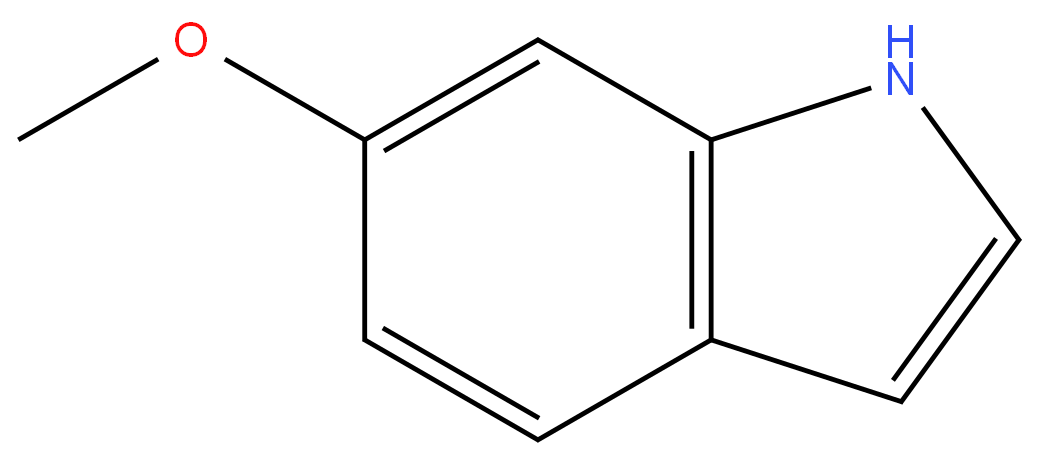6-Methoxyindole
Synonym(s):NSC 92517
- CAS NO.:3189-13-7
- Empirical Formula: C9H9NO
- Molecular Weight: 147.17
- MDL number: MFCD00022780
- EINECS: 221-689-6
- SAFETY DATA SHEET (SDS)
- Update Date: 2025-01-27 09:38:02

What is 6-Methoxyindole?
Chemical properties
white shiny crystals
The Uses of 6-Methoxyindole
6-Methoxyindole was used to study the fluorescence of protonated excited-state forms of serotonin and other related compounds in acid. It was used in the preparation of:
- tryptophan dioxygenase inhibitors pyridyl-ethenyl-indoles, potential anticancer immunomodulator
- indolylindazoles and indolylpyrazolopyridines, interleukin-2 inducible T cell kinase inhibitors
- diindolyloxyindoles, anticancer agents
- benzoylpiperazinyl-indolyl ethane dione derivatives, HIV-1 inhibitors
- 3-aroylindoles as anticancer agents
- indolyl and isoquinolinyl anthranilates, PPARδ partial agonists
- heteroaryl ketones, VEGFR-2 inhibitors
Synthesis Reference(s)
Synthesis, p. 735, 1986 DOI: 10.1055/s-1986-31759
Biochem/physiol Actions
6-Methoxyindole inhibits the chlorinating activity of myeloperoxidase and inhibits the generation of hypochlorous acid released by activated leukocytes.
Properties of 6-Methoxyindole
| Melting point: | 90-92 °C (lit.) |
| Boiling point: | 105°C 0,2mm |
| Density | 1.169±0.06 g/cm3(Predicted) |
| Flash point: | 105°C/0.2mm |
| storage temp. | Keep in dark place,Inert atmosphere,Room temperature |
| solubility | Methanol (Slightly) |
| pka | 17.22±0.30(Predicted) |
| form | Shiny Crystals |
| color | White |
| Sensitive | Light Sensitive |
| BRN | 116483 |
| CAS DataBase Reference | 3189-13-7(CAS DataBase Reference) |
| NIST Chemistry Reference | Indole, 6-methoxy-(3189-13-7) |
Safety information for 6-Methoxyindole
| Signal word | Warning |
| Pictogram(s) |
 Exclamation Mark Irritant GHS07 |
| GHS Hazard Statements |
H315:Skin corrosion/irritation H319:Serious eye damage/eye irritation H335:Specific target organ toxicity, single exposure;Respiratory tract irritation |
| Precautionary Statement Codes |
P261:Avoid breathing dust/fume/gas/mist/vapours/spray. P305+P351+P338:IF IN EYES: Rinse cautiously with water for several minutes. Remove contact lenses, if present and easy to do. Continuerinsing. |
Computed Descriptors for 6-Methoxyindole
| InChIKey | QJRWYBIKLXNYLF-UHFFFAOYSA-N |
New Products
Methyl (R)-1-Boc-4,4-difluoropyrrolidine-2-carboxylate 2,2-Difluoropropylamine hydrochloride tert-butyl 3-bromoazetidine-1-carboxylate (R)-1-Boc-3-hydroxypyrrolidine DIFLUOROACETIC ANHYDRIDE 2,2-Difluoropropionic acid Diallylamine, 99% Calcium hydroxide, 95% Aluminum oxide, basic 2-Bromophenylacetonitrile, 97% L-tert-Leucine,97% N-Hydroxy-2-methylpropanimidamide 4-(3,4-Dichlorophenyl)-3,4-Dihydro-N-Methyl-1-(2H)-Naphthalenimine (Schiff Base) 2-AMINO-3,5-DIBROMO BENZALDEHYDE [ADBA] L-Glutamic Acid Dimethyl Ester Hcl 10-Methoxy-5H-dibenz[b,f]azepine 5-Cyanophthalide N, N-Carbonyldiimidazole (CDI) Dibenzoyl Peroxide Titanium Dioxide 2-(Methylthio) Benzonitrile Sodium Acetate Anhydrous Allopurinol 1,5-DibromopentaneRelated products of tetrahydrofuran


![tert-butyl 7-oxo-2,6-diazaspiro[3.4]octane-2-carboxylate](https://img.chemicalbook.in/CAS2/GIF/1234616-51-3.gif)


![Acetic acid, [(5-chloro-2-pyridinyl)aMino]oxo-](https://img.chemicalbook.in/CAS/20150408/GIF/552850-73-4.gif)


You may like
-
 3189-13-7 6-Methoxy indole 98%View Details
3189-13-7 6-Methoxy indole 98%View Details
3189-13-7 -
 6-Methoxyindole CAS 3189-13-7View Details
6-Methoxyindole CAS 3189-13-7View Details
3189-13-7 -
![Cis-2-(Bromomethyl)-2-(2,4-Dichlorophenyl)-1,3-Dioxolane-4-Ylmethyl Benzoate [CBB] 61397-56-6 99%](https://img.chemicalbook.in//Content/image/CP5.jpg) Cis-2-(Bromomethyl)-2-(2,4-Dichlorophenyl)-1,3-Dioxolane-4-Ylmethyl Benzoate [CBB] 61397-56-6 99%View Details
Cis-2-(Bromomethyl)-2-(2,4-Dichlorophenyl)-1,3-Dioxolane-4-Ylmethyl Benzoate [CBB] 61397-56-6 99%View Details
61397-56-6 -
 Ethyl-2-Chloroacetoacetate 609-15-4View Details
Ethyl-2-Chloroacetoacetate 609-15-4View Details
609-15-4 -
 CIS- BROMO BENZOATEView Details
CIS- BROMO BENZOATEView Details
61397-56-6 -
 609-15-4View Details
609-15-4View Details
609-15-4 -
![1-(6-Methylpyridin-3-Yl)-2-[4-(Methylsulfonyl)Phenyl]Ethanone [Ketosulfone] 99%](https://img.chemicalbook.in//Content/image/CP5.jpg) 1-(6-Methylpyridin-3-Yl)-2-[4-(Methylsulfonyl)Phenyl]Ethanone [Ketosulfone] 99%View Details
1-(6-Methylpyridin-3-Yl)-2-[4-(Methylsulfonyl)Phenyl]Ethanone [Ketosulfone] 99%View Details
221615-75-4 -
 27143-07-3View Details
27143-07-3View Details
27143-07-3
Statement: All products displayed on this website are only used for non medical purposes such as industrial applications or scientific research, and cannot be used for clinical diagnosis or treatment of humans or animals. They are not medicinal or edible.
